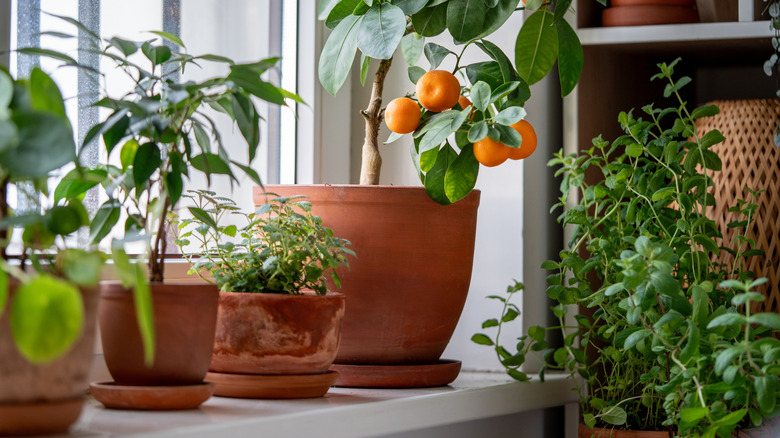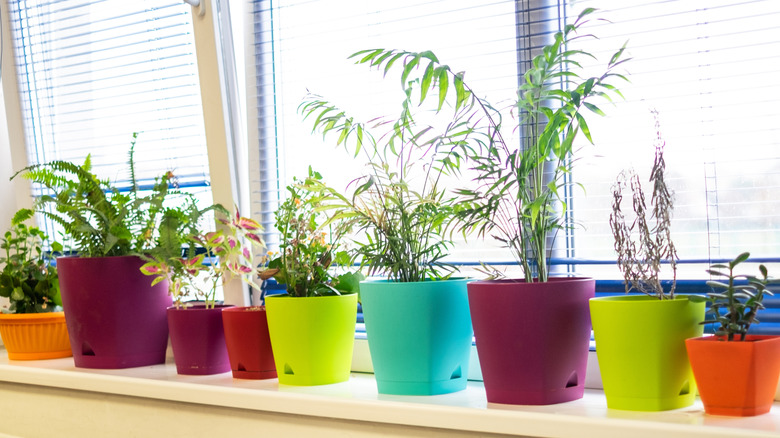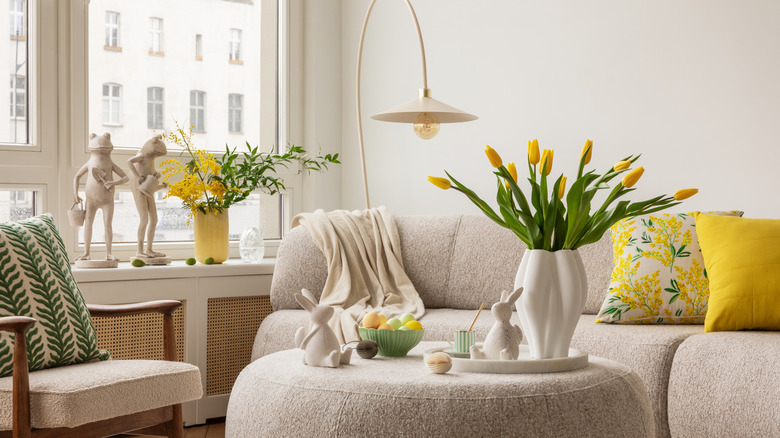How To Decide On Planter Colors For Your Indoor Space
Filling your home with houseplants has many benefits that stretch beyond just aesthetics. Indoor plants can reduce stress levels, increase attention spans, boost indoor air quality, encourage more productivity, and improve your mental health. For all of the ways these additions could change your life for the better, it seems only right to pick the best types of planters for your houseplants – in the right color. But how do you choose?
While there are quite a few color rules the Property Brothers swear by and the interior design color theory to keep in mind, planter color choices — like plants themselves — affect more than vibes, cohesion, or coordination. To decide on planter colors for your indoor space, consider the mood the hues may evoke, the design of the room, how the color will potentially affect the health of your plants, and aesthetics.
Planters are available in just about every color you can imagine. When making your choice, think about whether you want the planters to fade into the background or if you want them to stand out. Brown can work with any décor, and earthy tones can make it appear as though the pot is an extension of the plant. It's also a good color choice for the plant because the tones reflect the right amount of sunlight to keep the soil warm but not too warm. That's important, especially if your plant is near the window. White, black, and gray can also work with varying décors; white gives off minimalist, clean vibes, allowing the green to stand out, while black looks sleek and dramatic. For those wanting quiet sophistication, gray planters could be a solid choice.
Bold planter colors bring about emotion
Instead of sitting in the background and letting the plants stand on their own, you might choose to go the bold route, allowing the trendiest indoor planters to make a statement. Those with a seaside décor might opt for blues or greens. These colors are said to have a calm feeling. Blues and greens are also in the same color family as the green found in most houseplants, so the hues give continuity while also standing out. For those looking to bring brightness to a room, turn toward yellow. It's a bold shade that screams summer, adding vibrancy and happy vibes to your indoor space. Set them with purple or pink planters for even more energy.
Red and pink planters can also bring a touch of romance to your home, and can work well in small or darker spaces. These choices will also fit in nicely with eclectic décors, and can let your guests know you have a personality as bold as the planter colors you choose for your home. Remember, the colors of your planters not only reflect the mood you're trying to convey, but they can also directly affect the health of your plants. Darker colors lead to the soil holding more heat, while lighter hues reflect light and keep the soil cooler — especially near windows. So, it's important to consider the type of plant and its location when choosing your pot colors.
Working planters into your aesthetics
Now that you've looked at the moods that planter colors can bring and the effects different hues have on the health of your plants, you want to consider aesthetics. When thinking about planter colors, your choices will either harmonize with your existing décor or become an accent. Incorporate the planter colors into your décor by picking shades that complement your overall scheme, fitting opposite on the color wheel or within the same color family.
For example, blue and orange are on opposite sides and complement each other, while blue, green, and teal are in the same family and work together in a more symmetric way. If you already have an accent color in your home, think about choosing that same shade for your planter, as long as it will work well with the plant itself. Keep in mind that room size matters as well. For instance, avoid black in tight spaces, opting for a lighter option instead.
On the other hand, you could go the monochromatic route by choosing one hue and picking planters in different shades of that color. That choice will bring a connection like colors in the same family. Settling on a color for this look could either play on your accent tones, or be a neutral that goes with any style.


